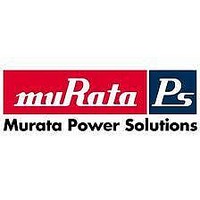ADS-932MM Murata Power Solutions Inc, ADS-932MM Datasheet - Page 3

ADS-932MM
Manufacturer Part Number
ADS-932MM
Description
Analog To Digital Converter
Manufacturer
Murata Power Solutions Inc
1. Obtaining fully specifi ed performance from the ADS-932 requires care-
2. The ADS-932 achieves its specifi ed accuracies without the need for exter-
3. Pin 35 (COMP. BITS) is used to select the digital output coding format of the
DATEL
Footnotes:
➀ All power supplies must be on before applying a start convert pulse. All supplies and
➁ When COMP. BITS (pin 35) is low, logic loading "0" will be –350μA.
➂ A 2MHz clock with a positive pulse width is used for all production testing. See
ANALOG OUTPUT
Internal Reference
External Current
DIGITAL OUTPUTS
Logic Levels
Delay, Falling Edge of ENABLE to
Output Coding
POWER REQUIREMENTS
Power Supply Ranges ➅
Power Supply Currents
Power Dissipation
Power Supply Rejection
TECHNICAL NOTES
the clock (START CONVERT) must be present during warmup periods. The device
must be continuously converting during this time. There is a slight degradation in
performance when operating the device in the unipolar mode.
Timing Diagram for more details.
40ns < Start Pulse < 175ns or 280ns < Start Pulse < 460ns
Bypass all power supplies and the +3.2V reference output to ground with
Pin 35 is TTL compatible and can be directly driven with digital logic in
ful attention to pc-card layout and power supply decoupling. The device's
analog and digital ground systems are connected to each other internally.
For optimal performance, tie all ground pins (4, 7, 30 and 36) directly to a
large analog ground plane beneath the package.
4.7μF tantalum capacitors in parallel with 0.1μF ceramic capacitors. Locate
the bypass capacitors as close to the unit as possible.
nal calibration. If required, the device's small initial offset and gain errors
can be reduced to zero using the adjustment circuitry shown in Figure 2.
When using this circuitry, or any similar offset and gain calibration hard-
ware, make adjustments following warmup. To avoid interaction, always
adjust offset before gain. Tie pins 5 and 6 to ANALOG GROUND (pin 4) if not
using offset and gain adjust circuits.
ADS-932 (see Tables 2a and 2b). When this pin has a TTL logic "0" applied,
it complements all of the ADS-932's B1-B16 & B1outputs.
applications requiring dynamic control over its function. There is an internal
pull-up resistor on pin 35 allowing it to be either connected to +5V or left
open when a logic "1" is required.
Voltage
Drift
Logic "1"
Logic "0"
Logic Loading "1"
Logic Loading "0"
Output Data Valid
+5V Supply
–5V Supply
+5V Supply
–5V Supply
®
+4.75
–4.75
–140
+2.4
MIN.
3.15
—
—
—
—
—
—
—
—
—
Straight Binary, Complementary Binary, Complementary Offset Binary, Complementary Two's Complement, Offset Binary, Two's Complement
®
• 11 Cabot Boulevard, Mansfi eld, MA 02048-1151 USA • Tel: (508) 339-3000 • www.datel.com • e-mail: help@datel.com
+25°C
+225
–135
+3.2
+5.0
–5.0
1.85
±30
TYP.
—
—
—
—
—
—
5
+5.25
±0.07
–5.25
MAX.
+0.4
3.25
260
2.0
+4
—
—
—
–4
20
—
+4.75
–4.75
–140
MIN.
3.15
+2.4
—
—
—
—
—
—
—
—
—
4. To enable the three-state outputs, connect OUTPUT ENABLE (pin 34) to a
5. Applying a start convert pulse while a conversion is in progress (EOC =
6. Do not enable/disable or complement the output bits or read from the FIFO
7. The OVERFLOW bit (pin 33) switches from 0 to 1 when the input voltage
8. When confi guring the ADS-932 for the unipolar mode, Pin 1 (+3.2V REF.)
➃ Effective bits is equal to:
➄ This is the time required before the A/D output data is valid once the analog input
➅ The minimum supply voltages of +4.9V and –4.9V for ±VDD are required for –55°C
(SNR + Distortion) – 1.76 +
logic "0" (low). To disable, connect pin 34 to a logic "1" (high).
logic "1") will initiate a new and probably inaccurate conversion cycle. Data
from both the interrupted and subsequent conversions will be invalid.
during the conversion process (from the rising edge of EOC to the falling
edge of EOC).
exceeds that which produces an output of all 1’s or when the input equals
or exceeds the voltage that produces all 0’s. When COMP BITS is activated,
the above conditions are reversed.
should be connected to Pin 2 (Unipolar) through a non-inverting op-amp.
For precision DC applications an OP- 07 type amplifi er is recommended,
while AC applications requiring the lowest level of harmonic distortion
should consider the AD9631.
When confi guring the ADS-932 for the bipolar mode, Pin 2 (Unipolar) should
be physically disconnected from the surrounding circuitry. This will help
prevent noise from coupling into the A/D.
0 to +70°C
is back within the specifi ed range. This time is only guaranteed if the input does not
exceed ±4.75V (bipolar) or +2 to –7.5V (unipolar).
operation only. The minimum limits are +4.75V and –4.75V when operating at
+125°C.
+225
–135
+3.2
+5.0
–5.0
1.85
TYP.
±30
—
—
—
—
—
—
5
+5.25
±0.07
–5.25
MAX.
3.25
+0.4
260
2.0
—
—
—
–4
+4
20
—
16-Bit, 2 MHz Sampling A/D Converters
6.02
–140
+2.4
+4.9
MIN.
3.15
–4.9
20 log
—
—
—
—
—
—
—
—
—
–40 TO +100°C
–55 to +125°C
Actual Input Amplitude
Full Scale Amplitude
+225
–135
+3.2
+5.0
–5.0
1.85
±30
TYP.
—
—
—
—
—
—
5
MDA_ADS-932.B03 Page 3 of 9
+5.25
±0.07
–5.25
MAX.
+0.4
3.25
260
2.0
+4
—
—
—
–4
20
—
ADS-932
%FSR/%V
ppm/°C
UNITS
Watts
Volts
Volts
Volts
Volts
Volts
mA
mA
mA
mA
mA
ns









